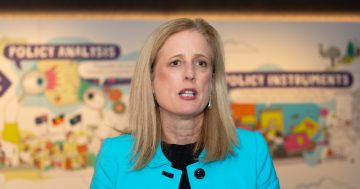As a parent at work, *Emma Walsh sees a global education and policy advisor business as campaigns for parental leave equality to create more family friendly workplaces.
 From July this year new parents will have more flexibility in how they apply for and share parental leave, as well as access to the new childcare reform package.
From July this year new parents will have more flexibility in how they apply for and share parental leave, as well as access to the new childcare reform package.
For a child born or adopted from 1 July 2023, the Commonwealth-funded Paid Parental Leave is up to 20 weeks (or 100 payable days).
The payment is flexible, meaning eligible families can claim it in multiple blocks until the child turns two.
There is no longer a requirement to return to work to be eligible for the entitlement.
Changes expand eligibility and purportedly give families more choice in how they share the leave. Notably, references to defining parents as a ‘primary’ and ‘secondary’ carer have been removed.
But many experts agree the much-needed PPL changes do not go far enough and argue that they won’t deliver the transformation required to encourage men to take up the leave.
To achieve paid-parental leave equality and see the benefits of parents better sharing care loads, it will take both the government, and employers, to seriously invest in funding, advocacy and education to shift the current status quo.
What do we mean by shared care in this context?
It means establishing a foundation supporting fathers to take extended periods of paid parental leave where they can bond with their child, take part in their early care, and then continue to play a strong role in the unpaid work at home.
You’ll also receive messages on behalf of our partners.
You can opt-out at any time. Achieving better balance in care helps everyone.
Fathers get more valuable time with their children, mothers have better opportunities to pursue paid work and their careers, children benefit from stronger connections with their parents, and the country sees an uptick in GDP thanks to greater women’s workforce participation.
The business case is powerful for the nation, just as it is powerful for employers to promote policies that can promote shared care to assist in attracting and retaining the best possible talent.
Australia has a long way to go in achieving this balance. Just 12% of those taking employer-paid ‘primary’ carer’s leave are men, according to the latest data for 2022 from the Workplace Gender Equality Agency, despite more than half of employers now offering it to men and women.
The ABS previously reported that dads account for just 5% of those taking the government-funded PPL on offer for primary carers.
Seventy per cent of women, compared with 42.4% of men, are participating in housework, and women are spending three hours and 34 minutes a day in childcare-related activities, compared to 2 hours and 19 minutes for men.
Meanwhile, fathers continue to face stigma and barriers around taking on this care.
Last week, new research from the Gidget Foundation found that only one in three new fathers felt well supported by their workplace after having a child, with only one in five feeling supported during their partner’s pregnancy.
Shared parental leave policies can help to narrow these gaps, foster an equal division of unpaid care and paid work, and improve the work-life balance of families.
The minimal increase to the number of weeks available under the Commonwealth-funded paid parental leave scheme from 1 July is to be followed by further incremental increases to reach 26 weeks by the year 2026.
This leave continues to be paid at the minimum wage. There is no requirement for employers to top up.
Unfortunately, even when elevated to 26 weeks, Australia still falls well behind the world’s leading nations on paid parental leave – who also happen to be world leaders on gender equality, according to the latest Gender Gap Index from the World Economic Forum.
Iceland, Norway and Finland took the top three spaces on this Index, with all three boasting PPL schemes that pay new parents more than a year of PPL, at around 80% of a parent’s wage. These countries also boast strong ‘use it or lose it’ provisions to encourage dads to take leave by making it financially viable to do so.
Back in Australia, the childcare reform package introduced this month is another small step towards enabling more parents to share the care, in that it should make additional days of care more affordable for families.
Too often, we hear of mothers in dual-parent, heterosexual households cutting back on work days or deciding not to return to work due to childcare costs making it “not worth it”.
While such costs should always be considered shared in such a household, a number of factors lead many mothers to see this as their cost to weigh up, when determining whether additional paid work makes financial sense.
Those factors include mothers earning less than fathers, and mothers being more likely to already work part-time or be returning to work following a career break.
The childcare reform package with the changes to the subsidy that appeared in payments from 10 July will make a real impact on making it easier for mothers to pick up additional days of work, or perhaps pursue early childhood education opportunities for their child for the first time.
The result? The opportunity to better share in paid work and ultimately better share the care.
So what next for promoting shared care in Australia? It’s unlikely we’re going to have further significant government-backed reform to paid parental leave in the near future.
Prime Minister Anthony Albanese has previously acknowledged that his government’s legislated changes are a “national minimum standard” and a foundation for a wider system, with “enlightened employers” competing to offer working parents the best possible deal.
It’s clear, the government is expecting employers to step in, and we need them to.
Employers funding PPL is on the rise. Many are adjusting their policies to meet the expectations of modern families and to attract and retain talent.
This includes removing ‘primary’ and ‘secondary’ carer labels, eliminating previous tenure requirements to ensure such leave is offered from day one on the job, and paying superannuation during periods of parental leave.
But it’s not just funding and flexibility that’s needed, we need employers to double down on pregnancy and carer discrimination that persists in workplaces. Gender bias around caring responsibilities is not only harmful to women’s workforce participation, pay and leadership representation, but it also hurts men when they are excluded from caregiving.
Men will not take parental leave if they do not feel it is ‘safe’ or affordable to do so.
Now is the time for more employers to recognise the business case for PPL and to do a health check on what they are currently offering to see how they can complement the government’s paid scheme.
We must also continue to advocate for greater commitment from the government to increase PPL funding beyond 2026 to be more in line with the OECD average of 53 weeks and to pursue a universal early childhood education system that delivers for Australian families and educators, not only for the sake of our future generation but also for our economic growth.
Parents At Work have today released the Whitepaper Advancing Shared Care in Australia through Paid Parental Leave: The business case for employers to take action.
The Whitepaper helps employers to understand the current state of play and what they can change to evolve policies that support their people but also their business.
*Emma Walsh is the CEO of Parents At Work, a global education and policy advisor business that campaigns for parental leave equality to create more family friendly workplaces.
This article was first published by Women’s Agenda.











